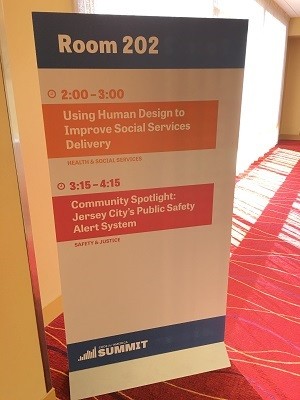Jersey City’s Open Data Initiatives Take Hold, Fueled by Google Ideas

Jersey City is making strides toward its goal of opening municipal government data to its residents, and of turning that data into something meaningful.
At the Annual 2015 Code for America Summit, in Oakland, Calif., Brian Platt, director of the Jersey City Office of Innovation, along with Open JC executives Akisia Grigsby, Emmanuel A. Simon and Sharad Hedge, participated in a panel discussion about the city’s newest initiative, “BeSafe.City” — the Jersey City public safety alert system.
The project, begun in collaboration with Google as part of the Google Ideas program, resulted in a platform that uses police data to identify any increases in crime in a particular area. Once the system determines that crime has risen over a specific threshold, it will send out a message informing residents of actions they can take to keep themselves and their property safe.
Platt notes that this isn’t a real-time system. “The last thing we want is citizens running to the scene of a crime.” However, it can alert people to crime trends and allow them to take precautions against them.
The system works by analyzing police “calls for service data” (dispatch data) initiated either by a call to 911 or by a police officer on the job. The tool digests all that information and identifies changes in activity based on geography over a set period of time.
It focuses on a geographical radius set by a user, for instance, around a child’s school, an office or a home. It reads through all the police activity, and compares that activity with a preset threshold.
“For example, if there are normally five bike thefts in your area of the city each week and suddenly the number spikes to 12, the program will recognize the earliest indication of that trend, but, more importantly, will send a text or email to subscribers providing specific information as to how to stay safe,” Platt said.
Platt said that Jersey City’s government is giving people more of what they want. They no longer have to go to a website and sort through pages and pages of data in order to figure out if there has been an increase in crime in their neighborhood.
And BeSafe.City is providing that information in a more modern way, through text messages on a phone and eventually through an app, now in development. “We are prioritizing expanded access to information and making that information more relevant and useful, which in this case will help improve the safety of our residents,” Platt said.
Open JC is the community partner for this initiative. This organization created a concept that could fulfill the vision laid out by Jersey City and Google, and is now developing that concept into a full system.
Platt explained that the city government wanted to open its data to the public, but couldn’t do so because it didn’t have the tech talent necessary. So he asked Open JC to determine if it had the programming talent to manage this kind of a development effort. “It turned out that it was very much in their scope of expertise.”
Google Ideas provided a $266,000 grant to fund the first phase of the project, Platt said.
NJTechWeekly.com asked him how Jersey City had become involved with Google, and Platt responded that two years ago Google and the mayor’s office got together to discuss ways in which the two entities could partner.
Google is proactive about reaching out to cities and trying to engage with the right people in order to push the open-government needle a little bit, according to Platt. The idea for BeSafe.City came out of those discussions and, “We decided to pursue it. It is costing us zero dollars.”
BeSafe.City is being piloted in three parts of the city, Paulus Hook, Bayside Park and South Greenville. They are very different neighborhoods that have different issues to contend with, Platt noted, but they each have an engaged tech community that can generate a high enough adoption rate and a large enough user base to test the alert system.
Simon commented that he and his colleagues at Open JC “are very excited to open BeSafe.City to our pilot communities soon, especially since this initiative leverages the synergy of technology, community engagements and key partnerships with the Public Safety Department, the mayor’s office and Google Ideas.”
“BeSafe.City will not only be the first launch of its kind, but Open JC has committed itself to releasing the source code as an open source project, so that it can be freely and easily implemented in other cities across the globe,” Simon added. “That means that Jersey City is not only leading the way, but making a clear path for others to follow.”
Platt noted that Jersey City had also revamped its Open Data Portal, making it easier to use. Mayor Steven Fulop announced the new portal on Oct. 13. According to Platt, the city had chosen to use the same vendor Newark was using for its data portal. It is based on CKAN open source data portal software, which allows access to data via Excel or Tableau, with charts that enable the user to better visualize the data.
“Our first iteration of the data portal allowed us to provide public access to raw data. This new version helps turn that raw data into something meaningful for people who don’t necessarily have the time or ability to process and analyze large data sets looking for answers,” Platt said.
Residents of Jersey City are invited to visit http://www.BeSafe.city to learn more about the program.

